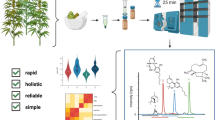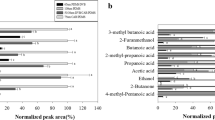Abstract
A rapid, accurate and low-cost detection method for simultaneous qualitative and quantitative analyses of serotonin and resveratrol was established with gas chromatography-mass spectrometry (GC–MS) combined with ultrasonic solvent extraction. With the optimal extraction conditions (60 min, 60 ℃, 80% ethanol solution and 1:200 w/v) and silane treatment, mass chromatograms (MC) were extracted from total ion chromatograms (TIC) using characteristic ions from silanized serotonin (m/z 174 and 218) and resveratrol (m/z 444) for qualitative and quantitative analyses. There were good linear relationships between the peak areas of the target compounds and their concentrations in the ranges 50–1000 μg/mL and 0.05–2.5 μg/mL, respectively, and the correlation coefficients (R2) were higher than 0.99. The relative standard deviation (RSD) was viewed as a measure of intraday and interday reproducibility, and those for retention time and peak area ranged from 0.005% to 0.09% and from 1.70% to 4.52%, respectively. The recovery levels for serotonin and resveratrol varied between 96.06% and 107.37%, between 94.82% and 101.09%, respectively. Moreover, the proposed method was used to detect the serotonin and resveratrol contents in different sea buckthorn organs from western China, and sea buckthorn branches and sea buckthorn growing in harsh environments may be excellent natural sources of serotonin and resveratrol, respectively.




Similar content being viewed by others
Data availability
The datasets generated and analyzed during the current study are available from the corresponding author on reasonable request.
References
A.K. Holik, K. Schweiger, V. Stoeger, B. Lieder, A. Reiner, M. Zopun, J.K. Hoi, N. Kretschy, M.M. Somoza, S. Kriwanek, M. Pignitter, V. Somoza, Gastric serotonin biosynthesis and its functional role in L-arginine-induced gastric proton secretion. Int. J. Mol. Sci. 22, 5881 (2021)
G. Redpath, N. Deo, Serotonin: an overlooked regulator of endocytosis and endosomal sorting? Biol. Open 11, bio059057 (2022)
L. Maroteaux, F. Kilic, Frontiers of serotonin beyond the brain. Pharmacol. Res. 140, 1–6 (2019)
P.P. Zhang, B. Wang, Y.M. Sun, J. Gao, K.Q. Lian, Analysis of 5-hydroxytryptamine and its related indoles in cerebrospinal fluid of leukemic children by gas chromatography-mass spectrometry. J. Lab. Med. 44(1), 41–45 (2020)
D. Ly, K. Kang, J.Y. Choi, A. Ishihara, K. Back, S.G. Lee, HPLC analysis of serotonin, tryptamine, tyramine, and the hydroxycinnamic acid amides of serotonin and tyramine in food vegetables. J. Med. Food. 11(2), 385–389 (2008)
Z.B. Li, H. Wang, L.Y.Y. Hu, J.L. Li, J.Y. Lin, B.N. Liu, Z.Q. Zhao, Y.L. Rao, Simultaneous determination of N-ethylpentylone, dopamine, 5-hydroxytryptamine and their metabolites in rat brain microdialysis by liquid chromatography tandem mass spectrometry. Biomed. Chromatogr. 33, e4626 (2019)
S.D. Feng, J.J. Wang, J. Teng, Z. Fang, C.T. Lin, Resveratrol plays protective roles on kidney of uremic rats via activating HSP70 expression. Biomed. Res. Int. 2020, 2126748 (2020)
Y. Chen, H. Li, G.X. Zhang, Y.Y. Wu, J.Y. Xiao, J.J. Liu, P.X. Qiu, X.J. Liu, L.L. Sun, B.Y. Du, Y.H. Tan, Synergistic inhibitory effect of resveratrol and TK/GCV therapy on melanoma cells. J. Cancer Res. Clin. 146, 1489–1499 (2020)
M.F. Yang, X. Yao, L.M. Chen, J.Y. Gu, Z.H. Yang, H.F. Chen, X. Zheng, Z.T. Zheng, Synthesis and biological evaluation of resveratrol derivatives with anti-breast cancer activity. Arch. Pharm. 2020, e2000044 (2020)
P. Wang, J.P. Gao, W.X. Ke, J. Wang, D.T. Li, R.L. Liu, Y. Jia, X.H. Wang, X. Chen, F. Chen, X.S. Hu, Resveratrol reduces obesity in high-fat diet-fed mice via modulating the structure and metabolic function of the gut microbiota. Free Radic. Biol. Med. 156(20), 83–98 (2020)
A. Jastrząb, E. Skrzydlewska, Composition and biomedical relevance of sea buckthorn. Acta Pol. Pharm. 76(6), 959ñ969 (2019)
K.W. Wang, Z.Z. Xu, X.J. Liao, Bioactive compounds, health benefits and functional food products of sea buckthorn: a review. Crit. Rev. Food Sci. 5, 1–22 (2021)
M.S. Marsiñach, A.P. Cuenca, The impact of sea buckthorn oil fatty acids on human health. Lipids Health Dis. 18, 145 (2019)
I. Sytařováa, J. Orsavováb, L. Snopeka, J. Mlčeka, L. Byczyńskic, L. Mišurcováa, Impact of phenolic compounds and vitamins C and E on antioxidant activity of sea buckthorn (Hippophaë rhamnoides L.) berries and leaves of diverse ripening times. Food Chem. 310, 125784 (2020)
S. Schubertová, Z. Krepsová, L. Janotková, M. Potoˇcˇnáková, F. Kreps, Exploitation of sea buckthorn fruit for novel fermented foods production: a review. Processes 9, 749 (2021)
J.H. Wang, C.R. Limao, C.D. Rezeng, Y.R. Suo, Technology of purification serotonin in seabuckthorn stems by macroporous resins. Food Sci. Technol. 39(10), 254–257 (2014)
I. Nicoletti, A.D. Rossi, G. Giovinazzo, D. Corradini, Identification and quantification of stilbenes in fruits of transgenic tomato plants (Lycopersicon esculentum Mill.) by reversed phase HPLC with photodiode array and mass spectrometry detection. J. Agric. Food Chem. 55, 3304–3311 (2007)
X. Huang, G. Mazza, Simultaneous analysis of serotonin, melatonin, piceid and resveratrol in fruits using liquid chromatography tandem mass spectrometry. J. Chromatogr. A 1218, 3890–3899 (2011)
Z.L. Lv, L.L. Gao, H.B. Gao, Z.X. Hou, B.L. Zhang, Improved determination of phoxim residue in stored wheat by HPLC with DAD. J. Food Sci. 74(5), 37–41 (2009)
S. Rocha, A.M. Araújo, A. Almeida, P.G. Pinho, E. Fernandes, Development and validation of a GC-MS/MS method for cis- and trans-resveratrol determination: application to Portuguese wines. Food Anal. Method. 12, 1536–1544 (2019)
V. Hook, T. Kind, S. Podvin, M. Palazoglu, C. Tran, T. Toneff, S. Samra, C. Lietz, O. Fiehn, Metabolomics analyses of 14 classical neurotransmitters by GC-TOF with LC-MS illustrates secretion of 9 cell−cell signaling molecules from sympathoadrenal chromaffin cells in the presence of lithium. ACS Chem. Neurosci. 10(3), 1369–1379 (2019)
K. Farhadi, F. Esmaeilzadeh, M. Hatami, M. Forough, R. Molaie, Determination of phenolic compounds content and antioxidant activity in skin, pulp, seed, cane and leaf of five native grape cultivars in West Azerbaijan province, Iran. Food Chem. 199, 847–855 (2016)
X.L. Zou, C. Tao, Y. Liu, M. Liu, J. Wu, Z.L. Lv, CO2 supercritical fluid extraction and characterization of polysaccharide from bamboo (Phyllostachys heterocycla) leaves. J. Food Meas. Charact. 12, 35–44 (2018)
Y. Wu, X. Han, W.Q. Yuan, D.H. Meng, J.Z. Hu, Z.L. Lv, Salt intervention for the diversities of essential oil composition, aroma and antioxidant activities of Kushui rose (R. setate×R. rugosa). Ind. Crop Prod. 150, 112417 (2020)
W.Q. Yuan, J.Z. Hu, L.Q. Yin, Z.L. Lv, Comparative analysis of essential bioactive components of oils originating from three Chinese Loess Plateau wild crops. J. Am. Oil Chem. Soc. 98, 531–540 (2021)
Y. Xu, S. Pan, Effects of various factors of ultrasonic treatment on the extraction yield of all-trans-lycopene from red grapefruit (Citrus Paradise Macf.). Ultrason. Sonochem. 20, 1026–1032 (2013)
Y. Liu, D.H. Meng, L.Z. Li, X.Y. Zhang, J.Z. Hu, Z.L. Lv, Preparation of bamboo leaf hydrosols by the steam-distillation extraction process. BioResources 13(3), 6922–6935 (2018)
T.E. Khawand, J.V. Fonayet, G.D. Costa, R. Hornedo-Ortega, M. Jourdes, C. Franc, G. de Revel, A. Decendit, S. Krisa, T. Richard, Resveratrol transformation in red wine after heat treatment. Food Res. Int. 132, 109068 (2020)
A. Babazadeh, A. Taghvimi, H. Hamishehkar, M. Tabibiazar, Development of new ultrasonic–solvent assisted method for determination of trans-resveratrol from red grapes: optimization, characterization, and antioxidant activity (ORAC assay). Food Biosci. 20, 36–42 (2017)
A.S. Ragab, J.V. Fleet, B. Jankowski, J.H. Park, S.C. Bobzin, Detection and quantitation of resveratrol in tomato fruit (lycopersicon esculentum Mill). J. Agric. Food Chem. 54, 7175–7179 (2006)
A.M. Rimando, W. Kalt, J.B. Magee, J. Dewey, J.R. Ballington, Resveratrol, pterostilbene, and piceatannol in Vaccinium berries. J. Agric. Food Chem. 52, 4713–4719 (2004)
M. Thakur, S. Bhattacharya, P.K. Khosla, S. Puri, Improving production of plant secondary metabolites through biotic and abiotic elicitation. J. Appl. Res. Med. Aroma. 12, 1–12 (2019)
Acknowledgements
This research was financially supported by the project of the Fundamental Research Funds for the Central Universities (No. 2015ZCQ-SW-05). And the authors are grateful for Beijing Forestry University and the financial project.
Author information
Authors and Affiliations
Contributions
DM: investigation, methodology, writing—original draft, writing—review & editing. YL: investigation, formal analysis. YZ, XM: data curation. XW: formal analysis. LC: supervision. ZL: revised manuscript critically for important intellectual content.
Corresponding author
Ethics declarations
Conflict of interest
The authors declare that they have no known competing financial interests or personal relationships that could have appeared to influence the work reported in this paper.
Ethical approval
This article does not contain any studies with human participants or animals performed by any of the authors.
Additional information
Publisher's Note
Springer Nature remains neutral with regard to jurisdictional claims in published maps and institutional affiliations.
Supplementary Information
Below is the link to the electronic supplementary material.
Rights and permissions
Springer Nature or its licensor (e.g. a society or other partner) holds exclusive rights to this article under a publishing agreement with the author(s) or other rightsholder(s); author self-archiving of the accepted manuscript version of this article is solely governed by the terms of such publishing agreement and applicable law.
About this article
Cite this article
Meng, Dh., Li, Yh., Zheng, Yq. et al. A rapid GC–MS method for the simultaneous determination of serotonin and resveratrol using characteristic ions: investigating the distributions of target compounds in different organs of sea buckthorn. Food Measure 17, 2537–2546 (2023). https://doi.org/10.1007/s11694-023-01807-w
Received:
Accepted:
Published:
Issue Date:
DOI: https://doi.org/10.1007/s11694-023-01807-w




